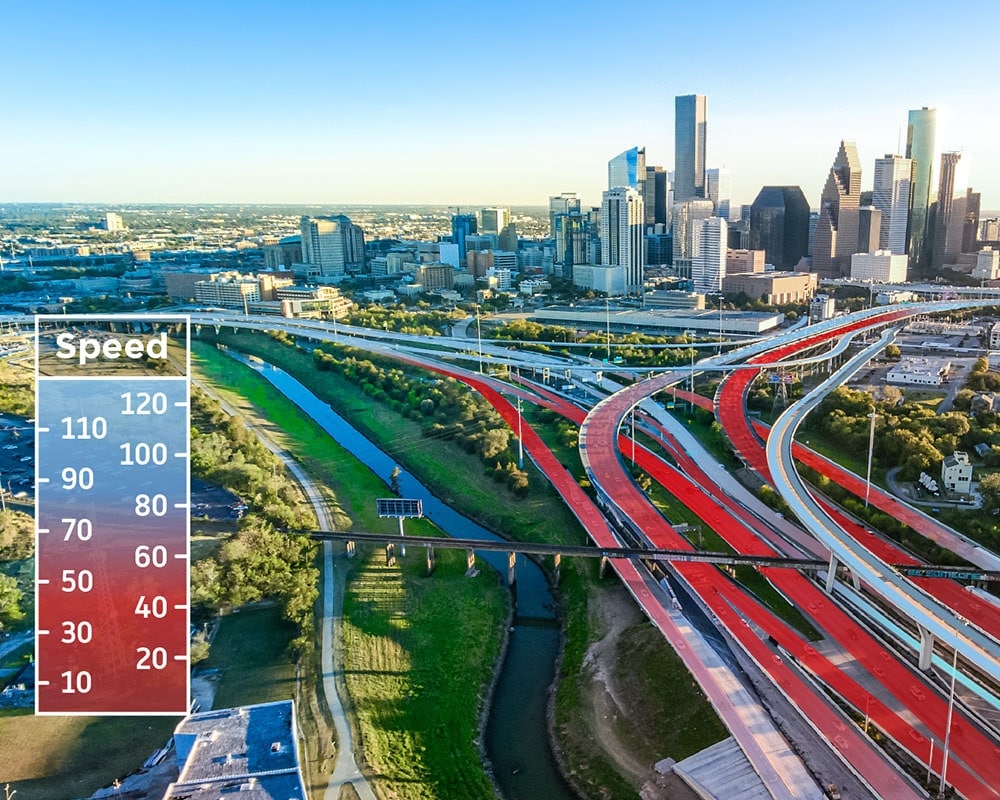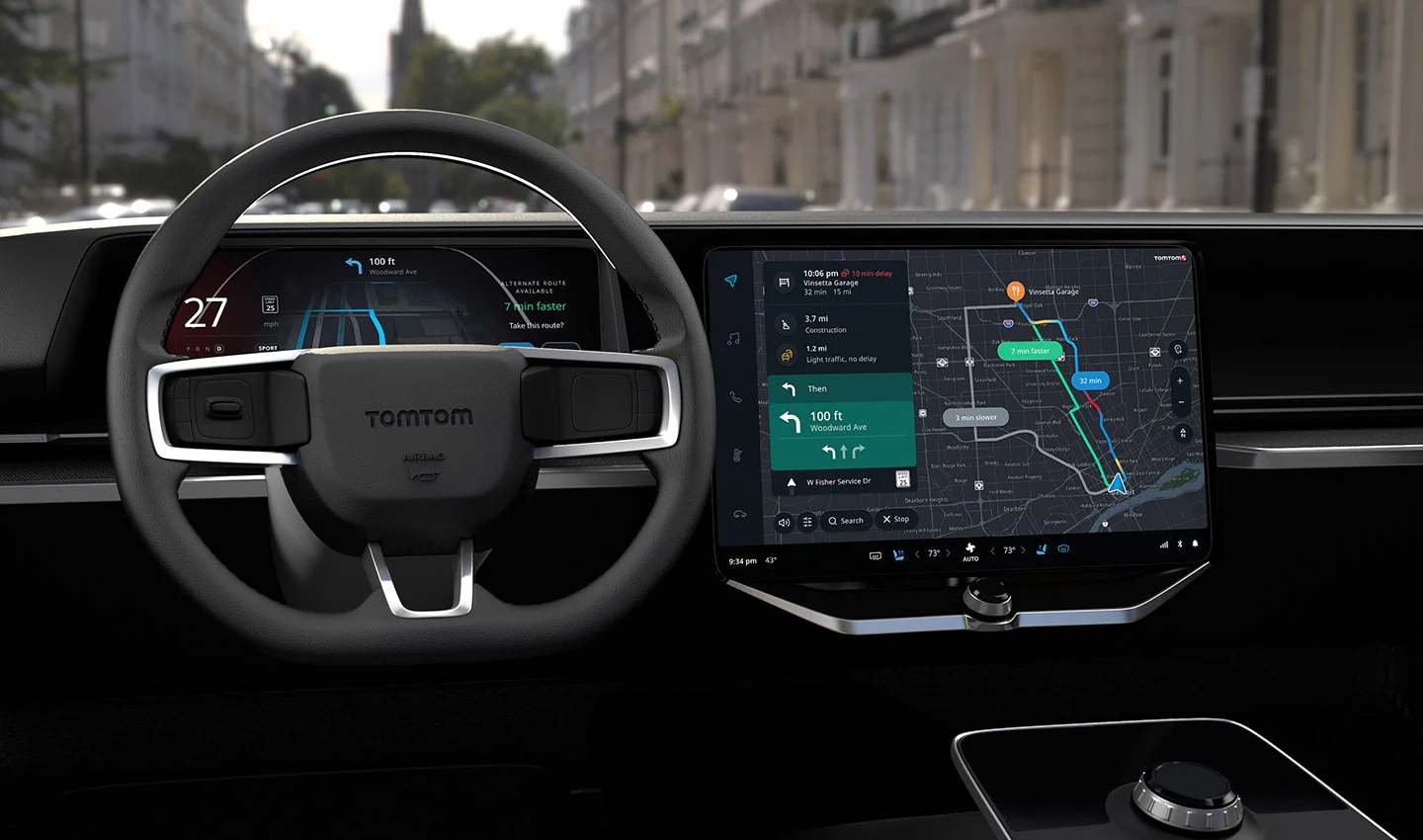
Traffic takes a toll on us all: wasting drivers’ time, costing cities billions each year and damaging the environment. To tackle traffic effectively, you need to know what to expect on the road ahead – and real-time and predictive traffic flow are means to help you gain these all-important insights.
When looking at the years before 2020, congestion levels in and around metropolitan areas all over the globe were on a continuous rise.
In Berlin, for example, an average evening rush hour trip in 2019 typically took 52% longer to complete than the same trip under free flow conditions. In Paris, rush hour trip times went up by as much as 79% on the most congested day of the year – October 29th, 2019. And in Moscow, the worst scoring day for traffic in 2019 was March 7th with 97% additional time required to reach the destination.
While streets were noticeably quieter throughout 2020, there were also days during lockdown with surprisingly high traffic. That was certainly the case in many European cities. In Athens and London, the day before new lockdown measures went into force was the most congested day in all of 2020: the congestion rate skyrocketed to 123% in Athens and reached 104% at its worst in London.
How traffic free flow and congestion levels will behave after the pandemic is fully over, remains to be seen. Current observations, however, are starting to show that traffic is already on its way back to “normal", continuously rising levels. Here are four key insights into how traffic flow data helps us keep up with changing congestion patterns, and how this visibility helps drive everything from accurate estimated times of arrival (ETAs) to reduced congestions.
In order to predict traffic on the road accurately, a detailed view of the current observed speeds and travel times on the entire road network is needed.
Insight #1: Traffic flow is big data at its finest
We source our traffic flow data from over 600 million devices, such as in-dash car navigation, smartphones, and telematics systems, collecting over 61 billion totally anonymous GPS data points each day. This real-time data is used to accurately display current congestion conditions on the road and is updated every 30 seconds, while covering the mind-blowing distance of 3.5 billion kilometres every 24 hours.
And in case you were wondering if that´s about it, no, it´s not: When real-time data becomes historical data, traffic patterns can be identified for each time of the day and each day of the week. 58 billion driving hours are accumulated in TomTom’s historical traffic data. That’s definitely enough to not only know the past – but predict the future.
So, in essence, TomTom’s Traffic Flow visualizes current and predicted traffic conditions on the road ahead and enables routing engines to not only propose alternative, faster routes, but also estimate the time of arrival most accurately. In other words: It helps drivers to get to their destination faster and safer and contributes its fair share to reducing congestion overall.
Traffic flow information isn´t old news. It’s a dynamic, continuously growing pool of future-ready innovation.
As we see the overall industry being driven by the CASE megatrends (Connected, Automated, Shared, Electrified) one of the biggest impacts on traffic flow is the shift towards higher levels of automation, which requires more detailed and extremely precise traffic information. It also means that innovations are driven at high speed, such as hazard warning messages that alert drivers to icy conditions or an accident on the road ahead, for example. These give drivers ample time to anticipate and react to adverse events, and also enable autonomous vehicles to take appropriate actions, such as reducing speed for adaptive cruise control or changing lanes.
Envisioning a future that follows the path of continuously growing congestion, as we have seen unfold in years running up to 2020, isn´t particularly motivating. CO2 emissions from road transportation are on the rise and time spent stuck in traffic is as well.
Looking at TomTom’s Traffic Index report for 2019, we saw that drivers spent an extra 87 minutes in traffic on average. And a 2019 mobility report suggests that in the US alone, the average commuter wastes 54 hours a year stuck in traffic. It also predicts that this figure will rise to 62 hours a year by 2025. Assuming 35 years of regular commuting, US drivers would spend 61 days of their life sitting in jams travelling to work and back.
Insight #2: Actionable innovation to reduce congestion
1. Traffic Visualization
So, what will help? Visionaries typically have big ideas to answer this rather broad question. Only time will tell if road transportation goes fully automated, up in the air with flying drone-like cars or underground in hyperloop tunnels. The foreseeable future, however, is hybrid. Adding lanes to highways, improving public transportation, investing in shared mobility, and promoting mixed solutions such as Park & Ride are one side of the story. The way vehicles are powered is another: Electric, combustion engine and maybe soon to come hydrogen vehicles will be sharing the roads of the future as autonomous, semi-autonomous and manual cars, buses, motorbikes, and trucks.
In the light of big ideas on how to make the world a safer, cleaner and congestion free place, non-revolutionary or disruptive solutions tend to get overshadowed. What can be done right now to help reduce hours wasted in traffic and improve congestion levels? Traffic flow plays a vital role in that, and two of the cornerstones of how it works are real-time traffic and traffic prediction. Why? Because they enable the routing algorithm to work its magic and choose the optimal route based on time, energy consumption and distance.
2. Routing and arrival times
In order to calculate the most accurate ETAs, TomTom looks at the road in small segments. These segments can be as short as 200m and as long as 3km depending on the road class.
The observed speeds – or traffic patterns – on each road segment give us insights into the overall speeds driven and subsequently the level of congestion on the road. Looking at the historical data of such segment speeds in combination with planned road closures and/or roadworks, real-time speeds and traffic jam evolution data allows us to make speed and congestion predictions for up to 24 hours in advance. This information also enables useful insights on best times to travel, as well as likely arrival times based on the routes offered by the routing engine and chosen by the driver.
 With detailed traffic flow data, embedded navigation systems can calculate ideal routes and precise arrival times.
With detailed traffic flow data, embedded navigation systems can calculate ideal routes and precise arrival times.Accompanying the market´s shift to more and more autonomous driving, another topic within the traffic flow context is gaining importance and traction: lane-level information.
Insight #3: The future of traffic flow is lane-level precision
While we are focused today on warning the driver about the traffic situation ahead, and leaving decision-making fully to the driver, the next step is to help the vehicle decide whether it is safe to drive autonomously or not. And looking even further ahead, the future is to communicate real-time traffic information to the vehicle so that it can adapt its driving accordingly and with lane-level accuracy while informing the driver why this happens.
The use cases for such a capability are multiple: Think about a lane-specific traffic jam while exiting the highway, or roadworks resulting in a lane closure. What about jam information where the speeds differ per lane? Or simply different speeds per lane during traffic free flow. Taking it one step further, what about reversible lanes and High Occupancy Vehicle (HOV) lanes? Respectively, these are lanes where the direction of travel changes depending on the time of the day, and restricted traffic lanes reserved for vehicles carrying two or more passengers, including carpools, vanpools, taxis and buses.
At TomTom, we are anticipating the automotive world’s needs for precise lane-level data, answering the above questions with concrete solutions, from lane-level hazard warnings, to speeds, turn-dependent events and country-specific data such as HOV.
Insight #4: Traffic flow in your car, onboard or cloud-based in-dash navigation
True to the motto, “the future is in the cloud”, traffic flow information can be found as part of TomTom’s cloud-native in-vehicle navigation software. Our online navigation delivers hyper-fast search, routing, real-time traffic information and map updates, and switches to onboard maps and traffic when there is no data connection available – making sure drivers always have access to the maps and guidance they need.
TomTom’s Navigation for Automotive is easily integrated with any brand, model, or vehicle type, including electric vehicles (EVs), trucks and motorbikes. No matter if you want a more out-of-the-box solution or prefer a customized approach, we deliver the most complete vehicle navigation on the market – as easy-to-use SDKs and APIs to integrate into your very own digital cockpit.
Moving towards a better future
While, at least for now, traffic remains an issue that we can't avoid entirely, accurate traffic flow information helps us get better at outmaneuvering it. With better insight into live congestion and sharper future predictions, we can all make smarter choices that save us time and money and make the roads a safer, cleaner place for everyone.
Find out how you can outsmart traffic and improve the navigation experience with TomTom Traffic.
People also read
)
How to gain back time: The mystery of travel time accuracy debunked
)
How TomTom and its partners help road authorities solve traffic challenges
)
Getting accurate estimated times of arrival when planning ahead
* Required field. By submitting your contact details to TomTom, you agree that we can contact you about marketing offers, newsletters, or to invite you to webinars and events. We could further personalize the content that you receive via cookies. You can unsubscribe at any time by the link included in our emails. Review our privacy policy. You can also browse our newsletter archive here.
)